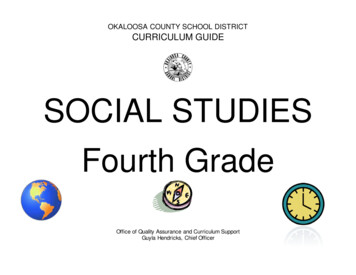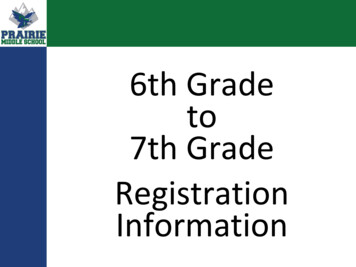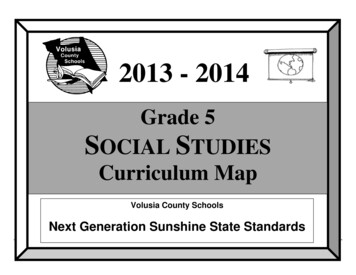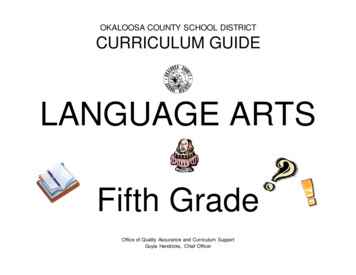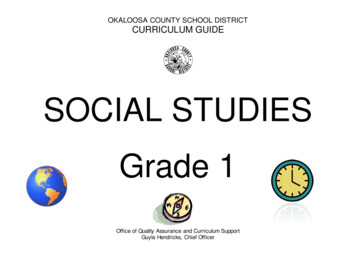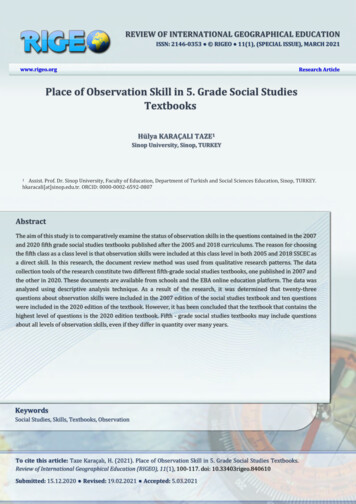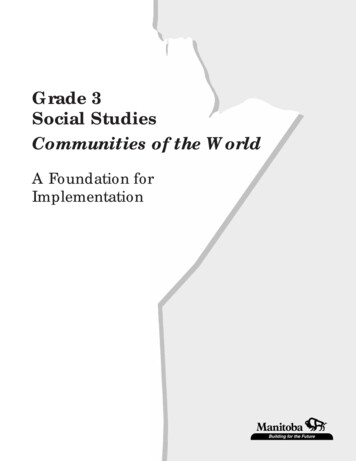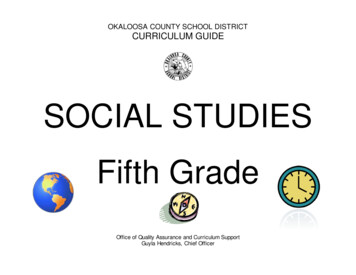
Transcription
OKALOOSA COUNTY SCHOOL DISTRICTCURRICULUM GUIDESOCIAL STUDIESFifth GradeOffice of Quality Assurance and Curriculum SupportGuyla Hendricks, Chief Officer
OKALOOSA COUNTY SCHOOL DISTRICTCurriculum Guide for Social StudiesCONTENTSMission Statement. 3Suggestions for Implementing Curriculum Guides . 3Florida Department of Education Essential Website . 3OCSD Curriculum and Pacing Guide Overview . 4Quarterly Benchmarks . 5Reading Standards for Informational Text K–5 . 8Grade-level Curriculum Guide . 9Quarter 1 . 9Quarter 2 . 15Quarter 3 . 21Quarter 4 . 28Reading Rainbow Selections Elementary Social Studies . 36Topic Requirements by Statute . 37Social Studies K-5 Websites and Resources. 38Additional Resources That Encompass All Units . 39Additional Literature . 39Additional Literature by Theme . 41REV 062012Fifth Grade Social StudiesPage 2
OKALOOSA COUNTY SCHOOL DISTRICTCurriculum Guide for Social StudiesMission StatementOkaloosa County teachers are committed to the teaching of social studies in accordance with the highest state and national st andards. We endorse theposition of the Florida Council for the Social Studies, which states “Florida’s public schools have the responsibility for creating an informed and activecitizenry. This goal requires our students to receive a firm foundation in each of the four major areas repre sented in the Sunshine State Standards for socialstudies-history, government/civics, economics, and geography.” We further recognize that our students must learn about our nation’s h eritage and possessessential economic, civic, geographic, and historical knowledge to equip them for their future responsibilities as citizens of Florida and the United States ofAmerica.Suggestions for Implementing Curriculum GuidesThe role of the teacher is to: Teach students the Next Generation Standards as dictated by state law for their grade level. Provide learning-rich classroom activities that teach the benchmarks in depth. Enhance the curriculum by using resources and instructional technology. Differentiate instruction by varying methods of instruction and assessment. Regularly administer assessments to include higher-level questions and performance tasks.In addition, teachers should: Collaborate with other grade-level teachers to maximize school resources and teacher expertise. Consult with other grade-levels to define absolute skill goals for each grade level. Document questions and suggestions for improvement of the curriculum guide. Integrate Social Studies with the Reading curriculum. Consider applying for a grant to support project-based learning for their school.Teachers may substitute a reading selection of their choice in lieu of one listed in the quarterly description if the selection alignsto the same set of benchmarks.Florida Department of Education Essential LStandardSearch.aspxREV 062012Fifth Grade Social StudiesPage 3
OKALOOSA COUNTY SCHOOL DISTRICTCurriculum Guide for Social StudiesOCSD Curriculum and Pacing Guide OverviewThis document provides a Social Studies curriculum and pacing guide. It is designed to help teachers efficiently pace the delivery of qualityinstruction for each nine-week period.(Purpose: This guide was created by a team of grade-level teachers to correlate to the Next Generation Standards with the goal of providingteachers ready access to resources for teaching those new standards and a pace for accomplishing benchmark mastery.Description:The OCSD Social Studies Curriculum Guide specifies the social studies content to be covered within each nine-week instructional period. Thisguide identifies Next Generation Standards (NGS) Benchmarks. Furthermore, it allows teachers to input information specific to their studentsor school needs. Top Block – Strand, Standard, Essential Questions, Vocabulary, Primary Literature, Activities Related to Primary Literature Column One – BenchmarkLists the specific Benchmark by number and states the Benchmark. Column Two – Text Alignment, Additional Resources/ActivitiesCites the School Education Group (McGraw-Hill) textbook chapters or pages that correlate to the Benchmark.Suggests instructional activities and materials to supplement the text and primary literature. Column Three – Supplemental LiteratureLists additional literature to extend learning. Column Four – Open: Specific to teacher, grade, subject, schoolServes as a placeholder for teachers to add information that is specific to their school’s or students’ needs.Of note: Benchmarks drive instructional decisions; the text is a resource. Results of assessment are used to adjust and revise instruction.REV 062012Fifth Grade Social StudiesPage 4
OKALOOSA COUNTY SCHOOL DISTRICTCurriculum Guide for Social StudiesQuarterly BenchmarksQuarter 1Quarter 2*Required observance: Constitution Day – September 17thSS.5.G.1.4 Construct maps, charts, and graphs to display geographic information.SS.5.G.3.1 Describe the impact that past natural events have had on human andphysical environments in the United States through 1850.SS.5.G.4.1 Use geographic knowledge and skills when discussing current events.SS.5.G.4.2 Use geography concepts and skills such as recognizing patterns,mapping, graphing to find solutions for local, state, or national problems.SS.5.G.1.2 Use latitude and longitude to locate places.SS.5.G.1.3 Identify major United States physical features on a map of North America.SS.5.A.1.1 Use primary and secondary sources to understand history.SS.5.A.1.2 Utilize timelines to identify and discuss American history time periods.SS.5.G.1.1 Interpret current and historical information using a variety of geographictools.SS.5.A.2.1 Compare cultural aspects of ancient American civilizations (Navajo,Pueblo, Cahokia, Anasazi, Inuits, Mayans, Tlingit, Kwakiutl, Creek,Iroquios)SS.5.E.2.1 Recognize the positive and negative effects of voluntary trade amongNative Americans, European explorers, and colonists.SS.5.E.1.1 Identify how trade promoted economic growth in North America from PreColombian times to 1850.SS.5.A.2.2 Identify Native American tribes from different geographic regions on NorthAmerica (cliff dwellers and Pueblo people of the desert Southwest,coastal tribes of the Pacific Northwest, nomadic nations of the GreatPlains, woodland tribes east of the Mississippi River).SS.5.A.2.3 Compare cultural aspects of Native American tribes from differentgeographic regions of North America including but not limited to clothing,shelter, food, major beliefs and practices, music, art, and interactions withthe environment.SS.5.A.3.1 Describe technological developments that shaped European exploration.SS.5.A.3.2 Investigate (nationality, sponsoring country, motives, dates and routes oftravel accomplishments) the European explorers.SS.5.A.3.3 Describe interactions among Native Americans, Africans, English, French,Dutch, and Spanish for control of North America.SS.5.E.1.1 Identify how trade promoted economic growth in North America from PreColombian times to 1850.SS.5.E.2.1 Recognize the positive and negative effects of voluntary trade amongNative Americans, European explorers, and colonistsSS.5.A.4.1 Identify the economic, political and socio-cultural motivation for colonialsettlement.SS.5.A.4.2 Compare characteristics of New England, Middle, and Southern colonies.SS.5.G.1.5 Identify and locate the original thirteen colonies on a map of NorthAmerica.SS.5.A.4.3 Identify significant individuals responsible for the development of the NewEngland, Middle, and Southern colonies.SS.5.A.4.4 Demonstrate an understanding of political, economic, and social aspectsof daily colonial life in the thirteen coloniesSS.5.E.1.1 Identify how trade promoted economic growth in North America from PreColombian times to 1850.SS.5.E.1.3 Trace the development of technology and the impact of major inventionson business productivity during the early development of the United States.SS.5.E.1.2 Describe a market economy, and give examples of how the colonial andearly American economy exhibited these characteristics.SS.5.A.4.5 Explain the importance of Triangular Trade linking Africa, the West Indies,British Colonies, and Europe.SS.5.A.4.6 Describe the introduction, impact, and role of slavery in the colonies.Common Core Standards:See page 7—Reading Standards for Informational Texts K-5Common Core Standards:See page 7—Reading Standards for Informational Texts K-5Suggested Reading Selections:The Scrambled States of America by Laurie KellenGreetings From the 50 States by Sheila Keenan and Selina AlkoTeacher choice of non-fiction reading selections on varying Native American tribesREV 062012Suggested Reading Selections:Around the World in 100 Years From Henry the Navigator to Magellan by JeanFritzIf You Lived in Colonial Times by Ann McGovernFifth Grade Social StudiesPage 5
OKALOOSA COUNTY SCHOOL DISTRICTCurriculum Guide for Social StudiesQuarter 3Quarter 3 (cont.)SS.5.A.5.1 Identify and explain significant events leading up to the American Revolution.SS.5.E.1.1 Identify how trade promoted economic growth in North America from PreColombian times to 1850.SS.5.A.5.2 Identify significant individuals and groups who played a role in the AmericanRevolution.SS.5.C.2.1 Differentiate political ideas of Patriots, Loyalists and “undecided’s” during theAmerican Revolution.SS.5.C.2.2 Compare forms of political participation in the colonial period to today.SS.5.A.5.3 Explain the significance of historical documents including key political concepts,origins of these concepts, and their role in American independence.SS.5.A.5.4 Examine and explain the changing roles and impact of significant women duringthe American Revolution.SS.5.A.5.5 Examine and compare major battles and military campaigns of the AmericanRevolution.SS.5.A.5.6 Identify the contributions of foreign alliances and individuals to the outcome ofthe Revolution.SS.5.A.5.7 Explain economic, military, and political factors which led to the end of theRevolutionary War.SS.5.A.5.8 Evaluate the personal and political hardships resulting from the AmericanRevolution.SS.5.A.5.9 Discuss the impact and significance of land policies developed under theConfederation Congress.SS.5.A.5.10 Examine the significance of the Constitution including its key political concepts,origins of those concepts, and their role in American democracy.SS.5.C.1.1 Explain how and why the United States government was created.*SS.5.C.1.2 Define a constitution, and discuss its purposes.SS.5.C.1.3 Explain the definition and origin of rights.*SS.5.C.1.4 Identify the Declaration of Independence’s grievances and Articles ofConfederation’s weaknesses.SS.5.C.1.5 Describe how concerns about individual rights led to the inclusion of the Bill ofRights in the U.S. Constitution.*SS.5.C.3.5 Identify the fundamental rights of all citizens as enumerated in the Bill of Rights.SS.5.C.1.6 Compare Federalist and Anti-Federalist views on government.SS.5.C.3.1 Describe the organizational structure (legislative, executive, judicial branches)and powers of the federal government as defined in Articles I, II, III of the U.S.Constitution.SS.5.C.3.2 Explain how popular sovereignty, rule of law, separation of powers, checks andbalances, federalism, and individual rights limit the power of the federalgovernment as expressed in the Constitution and Bill of Rights.SS.5.C.3.3 Give examples of powers granted to the federal government and thosereserved for the states.SS.5.C.3.4 Describe the amendment process as defined in Article V of the Constitution andgive examples.SS.5.C.3.6 Examine the foundations of the United States legal system by recognizing therole of the courts in interpreting law and settling conflicts.SS.5.C.1.6 Compare Federalist and Anti-Federalist views on government.REV 062012Common Core Standards:See page 7—Reading Standards for Informational Texts K-5Suggested Reading Selections:Johnny Tremain by Esther ForbesShh! We’re Writing the Constitution by Jean Fritz*Indicates a civics benchmarkQuarter 4SS.5.G.2.1 Describe the push-pull factors (economy, natural hazards, tourism, climate,physical features) that influenced boundary changes within the United States.SS.5.G.3.1 Describe the impact that past natural events have had on human and physicalenvironments in the United States through 1850.SS.5.A.6.1 Describe the causes and effects of the Louisiana Purchase.SS.5.A.6.2 Identify roles and contributions of significant people during the period ofwestward expansion.SS.5.A.6.3 Examine 19 th century advancements (canals, roads, steamboats, flat boats,overland wagons, Pony Express, railroads) in transportation andcommunication.SS.5.E.1.3 Trace the development of technology and the impact of major inventions onbusiness productivity during the early development of the United States.SS.5.A.6.4 Explain the importance of the explorations west of the Mississippi River.SS.5.A.6.5 Identify the causes and effects of the War of 1812.SS.5.A.6.6 Explain how westward expansion affected Native Americans.SS.5.A.6.7 Discuss the concept of Manifest Destiny.SS.5.A.6.8 Describe the causes and effects of the Missouri Compromise.SS.5.A.6.9 Describe the hardships of settlers along the overland trails to the west.Common Core Standards:See page 7—Reading Standards for Informational Texts K-5Suggested Reading Selections:If You Traveled in a Covered Wagon by Ellen LevineFifth Grade Social StudiesPage 6
OKALOOSA COUNTY SCHOOL DISTRICTCurriculum Guide for Social StudiesYear-long SS.5.G.2.1SS.5.G.3.1SS.5.G.4.1SS.5.G.4.2Use primary and secondary sources to understand history.Utilize timelines to identify and discuss American history time periods.Interpret current and historical information using a variety of geographic tools.Construct maps, charts, and graphs to display geographic information.Describe the push-pull factors (economy, natural hazards, tourism, climate, physical features) that influenced boundary changes within the United States.Describe the impact that past natural events have had on human and physical environments in the United States through 1850.Use geographic knowledge and skills when discussing current events.Use geography concepts and skills such as recognizing patterns, mapping, graphing to find solutions for local, state, or national problems.Common Core StandardsSee page 7REV 062012Fifth Grade Social StudiesPage 7
OKALOOSA COUNTY SCHOOL DISTRICTCurriculum Guide for Social StudiesReading Standards for Informational Text K–5Grade 5 Students1. Quote accurately from a text when explaining what the text says explicitly and when drawing inferences from thetext.Key Ideas and Details2. Determine two or more main ideas of a text and explain how they are supported by key details; summarize thetext.3. Explain the relationships or interactions between two or more individuals, events, ideas, or concepts in a historical,scientific, or technical text based on specific information in the text.4. Determine the meaning of general academic and domain-specific words or phrases in a text relevant to a grade 5topic or subject area.Craft and Structure5. Compare and contrast the overall structure (e.g., chronology, comparison, cause/effect, problem/solution) ofevents, ideas, concepts, or information in two or more texts.6. Analyze multiple accounts of the same event or topic, noting important similarities and differences in the point ofview they represent.7. Draw on information from multiple print or digital sources, demonstrating the ability to locate an answer to aquestion quickly or to solve a problem efficiently.Integration of Knowledge andIdeas8. Explain how an author uses reasons and evidence to support particular points in a text , identifying which reasonsand evidence support which point(s).9. Integrate information from several texts on the same topic in order to write or speak about the subjectknowledgeably.Range of Reading and Levelof Text ComplexityREV 06201210. By the end of the year, read and comprehend informational texts, inclu ding history/social studies, science, andtechnical texts, in the grades 4-5 text complexity band independently and proficiently.Fifth Grade Social StudiesPage 8
OKALOOSA COUNTY SCHOOL DISTRICTCurriculum Guide for Social StudiesGrade-level Curriculum GuideQuarter 1Required observance of Constitution Day, September 17thReading Standards for Informational Text Emphasized in this Quarter:By the end of the year, read and comprehend informational texts, including history/social studies, science, and technical texts, at the high end of thegrades 4-5 text complexity band independently and proficiently.STRAND: GeographySTANDARD: The World In Spatial TermsEssential Questions: How is latitude and longitude used to locate places on Earth? What are the major physical features in North America? What are the names of the states and state capitals? Where are the states located?Primary Literature: The Scrambled States of America by Laurie KellerActivities: Have students select a state, research important information (e.g. geography, climate, history, state symbols, tourism/places to visit, government and how itworks, economy/manufacturing/natural resources, population, interesting facts). Students will then present the information; consider use of technology forthis purpose (e.g., power point). Create a brochure for a selected state that would promote tourism. Create a physical map of a state or region, highlighting important physical features ( e.g., mountain ranges, major rivers, deltas, peninsulas, plains,plateaus, mesa, etc).REV 062012Fifth Grade Social StudiesPage 9
OKALOOSA COUNTY SCHOOL DISTRICTCurriculum Guide for Social StudiesBenchm arkText Alignm entAdditional Resources/ActivitiesSS.5.G.1.2Use latitude and longitude to locate places.Lesson #1: The World in Spatial TermsPgs. 10-15SS.5.G.1.3Identify major United States physical features on amap of North America.Essential Question: How do we showlocation?SS.5.G.1.6Locate and identify states, capitals, and UnitedStates territories on a map.Supplem ental Literature Greetings From the 50 Statesby Shelia Keenan and SelinaAlko Nystron Atlas of Our CountryOpen: Specific to teacher, grade,subject, schoolVocabulary: geographers, intersect, latitude,longitude, relative location, absolute locationLesson #2: Geography of the United StatesPgs. 16-27Essential Question: How do we describelocation?Vocabulary: influence, contiguous,territorities, navigable, tributary, canyonTechnology Resources:Standard 1: The World in Spatial TermsBrainpop – Latitude and Longitude titudeandlongitude/ SS.5.G.1.2Brainpop – Map Skills pskills/ SS.5.G.1.2Video – Reading Maps and Globes Students review the compass rose and add intermediate directions to their understanding as they locate continents, oceans, and the equatoron a map. Mental maps and the grid map are also reviewed and expanded with simple parallels and meridians. Students will locate major countries and use scale to trace travelroutes, determine distance between locations, and introduce new visuals to their understanding of mental maps. By locating the regions of the United States and the NativeAmerican tribes that called them home, the ideas behind cultural geography are simply introduced. Students locate lakes, rivers, and mountains on a new introduction, thelandform map. dAssetId 7E2A0F8E-9A78-405A-B806-F804449156A4&blnFromSearch 1&productcode US# SS.5.A.2.2,SS.5.G.1.1, SS.5.G.1.2, SS.5.G.1.3Standard 2: Places and RegionsBrainpop – Map Skills pskills/ SS.5.G.2.1REV 062012Fifth Grade Social StudiesPage 10
OKALOOSA COUNTY SCHOOL DISTRICTCurriculum Guide for Social StudiesSTRAND: American HistorySTANDARD: Pre-Colombian North AmericaEssential Questions: How are specific ancient civilizations, identified by the teacher, alike and different? Why do people trade, and what are the impacts of trade on certain groups of people? How did the environment influence where and how the Native Americans settled?Primary Literature: Selection of non-fiction books on varying Native American tribesActivities: Conduct research on a specific Native American region (Eastern woodlands, Southwest, Plains, and Pacific Northwest). Students can be grouped to createmodels of the types of homes common to a specific region. Create a graphic organizer comparing and contrasting several Native American groups. Write a narrative from the perspective of an early Native American, describing what it was like to first see European explorers . Have students make or bring in items from home that they could trade with other students . Have students engage in a trading activity and reflect on the results (e.g., identify which items were more in demand and, from that, determine how demandimpacts trading practices).REV 062012Fifth Grade Social StudiesPage 11
OKALOOSA COUNTY SCHOOL DISTRICTCurriculum Guide for Social StudiesBenchm arkSS.5.A.2.1Compare cultural aspects of ancient Americancivilizations (Aztecs/ Mayans; MoundBuilders/Anasazi/Inuit).SS.5.E.1.1Identify how trade promoted economic growth inNorth America from Pre-Colombian times to 1850.Text Alignm entAdditional Resources/ActivitiesSupplem ental LiteratureOpen: Specific to teacher,grade, subject, schoolMcGraw-HillUnit #2Lesson #1: Ancient CulturesPgs. 40-49Essential Question: What makes acivilization?Vocabulary: culture, development,civilization, slavery, empire, irrigationSS.5.A.2.2Identify Native American tribes from differentgeographic regions on North America (cliff dwellersand Pueblo people of the desert Southwest, coastaltribes of the Pacific Northwest, nomadic nations ofthe Great Plains, woodland tribes east of theMississippi River).SS.5.A.2.3Identify Native American tribes from differentgeographic regions on North America (cliff dwellersand Pueblo people of the desert Southwest, coastaltribes of the Pacific Northwest, nomadic nations ofthe Great Plains, woodland tribes east of theMississippi River).SS.5.A.1.1Use primary and secondary sources to understandhistory.S.5.A.2.2Identify Native American tribes from differentgeographic regions on North America (cliff dwellersand Pueblo people of the desert Southwest, coastaltribes of the Pacific Northwest, nomadic nations ofthe Great Plains, woodland tribes east of theMississippi River).REV 062012Lesson #2 Native Americans of theSouthwest, Pacific Northwest, Great Plains,Eastern WoodlandsPgs. 50-53, 54-57, 58-61, 62-67Buffalo Hunt by Russell FreedmanSign of the Beaver by Elizabeth GeorgeSpeareEssential Question Lessons 2-5:How does location affect the way peoplelive?Vocabulary:Lesson 2- kachina, migrate, Hogan,translateLesson 3 – typically, totem pole, potlatchLesson 4 – prairies, characteristic, nomads,teepee, lodgeLesson 5- slash, conduct, aspect,longhouse, wampum, confederacyFifth Grade Social StudiesPage 12
OKALOOSA COUNTY SCHOOL DISTRICTCurriculum Guide for Social StudiesSS.5.A.2.3Identify Native American tribes from differentgeographic regions on North America (cliff dwellersand Pueblo people of the desert Southwest, coastaltribes of the Pacific Northwest, nomadic nations ofthe Great Plains, woodland tribes east of theMississippi River).SS.5.G.1.1Interpret current and historical informationusing a variety of geographic tools.SS.5.G.1.6Locate and identify states, capitals, and UnitedStates territories on a map.Technology Resources:Standard 2: Pre-Columbian North AmericaBrainpop – American Indians - ericanindians/ SS.5.A.2.1, SS.5.A.2.2, SS.5.A.2.3Brainpop – Aztec Civilization - /azteccivilization/ SS.5.A.2.1Brainpop – Maya Civilization - /mayacivilization/ SS.5.A.2.1Brainpop – Inca Civilization - /incacivilization/ SS.5.A.2.1Video – Ancient Americans: The Mayas and Aztecs The voyage of Christopher Columbus in 1492 united two worlds: one was the world of the European civilization and theother was an entirely new world, unknown to the Europeans. In easily understood language, this program explores the ancient Americans, including the sophisticated Mayacivilization and the vibrant but bloody culture of the Aztecs. The first part traces the roots of human culture in the New World and explains the emergence of civilizations in Centraland South America. Students will learn about the mysterious Olmec culture and the brilliant civilization of the Mayas. Students then explore the ancient peoples of Central Mexico,including the fabulous civilization at Teotihuaca, the Toltect Culture, and the Chichimec barbarians. dAssetId 3E48B0182929-460D-946B-4A35FC44C2E2&blnFromSearch 1&productcode US SS.5.A.2.1Video – The Anasazi: Builders of America’s First Cities The Native-American culture known as the Anasazi lived in the American Southwest between 700 BC and 1600 AD. Thisprogram explores their incredible cliff cities, constructed in the massive land forms of the desert, the first civilizations of their kind in America. Beginning as nomadic hunters-andgatherers, the Anasazi evolved into an agricultural community with extensive villages, or pueblos. Religion was also central to their lives. They became expert basket weaversand potters; some of their exquisite craft survives today. As we follow the development of Anasazi civilization, we also expl ore concurrent European history, which adds a uniqueperspective to this study of early Native-American life. dAssetId 20C5EE49-99E3-4832-9C602DE6580344F9&blnFromSearch 1&productcode US SS.5.A.2.1Video - Native Americans: The First Peoples: Examine the life-styles of Native Americans who lived in the Eastern Woodlands, the Great Plains, the Southwest Desert, theREV 062012Fifth Grade Social StudiesPage 13
OKALOOSA COUNTY SCHOOL DISTRICTCurriculum Guide for Social StudiesPacific Northwest, and the Arctic. Witness what happened when the white man arrived with his different cultural beliefs. United ex.cfm?guidAssetId 97425877-CD16-45EC-AE6A-D45FBF80DFF3&blnFromSearch 1&productcode US SS.5.A.3.3, SS.5.A.2.2Video - Elementary Video Series: Native Americans: When European settlers came to North America, it was inhabited by tribes of people with strong cultural traditions and tiesto the land. What happened to those people and their customs? Explore the history and cultures of the Cherokees, Venetie, and Nez Perce. United ex.cfm?guidAssetId E24391DA-B442-437E-BAD9-2F47B5B72A9B&blnFromSearch 1&productcode US SS.5.A.3.3, SS.5.A.2.2Video – Reading Maps and Globes Students review the compass rose and add intermediate directions to their understanding as they locate continents, oceans, and the equatoron a map. Mental maps and the grid map are also reviewed and expanded with simple parallels and meridians. Students will locate major countries and use scale to trace travelroutes, determine distance between locations, and introduce new visuals to their understanding of mental maps. By locating the regions of the United States and the NativeAmerican tribes that called them home, the ideas behind cultural geography are simply introduced. Students locate lakes, rivers, and mountains on a new introduction, thelandform map. dAssetId 7E2A0F8E-9A78-405A-B806-F804449156A4&blnFromSearch
REV 062012 Fifth Grade Social Studies Page 4 OCSD Curriculum and Pacing Guide Overview This document provides a Social Studies curriculum and pacing guide. It is designed to help teachers efficiently pace the delivery of quality . Cites the School Education Group (McGraw-Hill) textbook
